A Diary of Lidos Alive
Lidos Alive aims to look at the lidos in the 'Boroughs' of Twickenham and Richmond (which became the London Borough of Richmond upon Thames in 1965) – those which have evolved over time and those lost. There has not been a new build lido in our Borough since the 1960s.
The word “lido” (pronounced LEE-doh) is a public open-air swimming pool or bathing beach.
It is known that there were beaches along the banks of the Thames which were the lidos for local people. These too are of interest.
We shall look at the original lido movement with its heyday in the first half of the twentieth century and the current lido revival. This revival has seen lidos saved and renovated and campaigns to bring back old lidos. In this historical context we will look at an example of a modern renovation and compare this to lidos locally.
Archival research is important in this project but the memories and information from those who are, or have been, associated with outdoor swimming will form a valuable contribution.
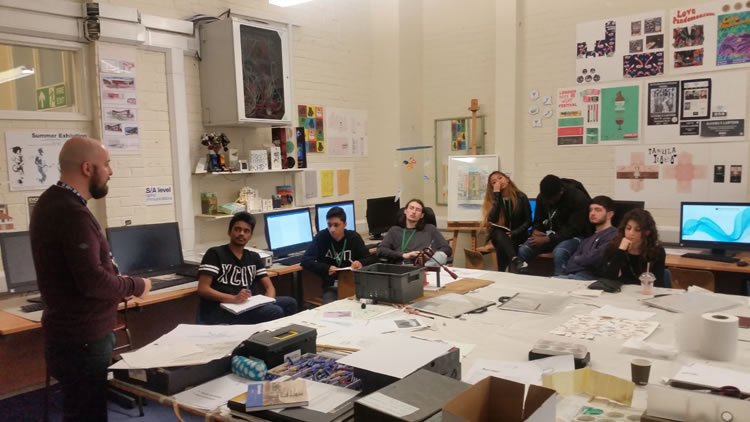
Archival research training
The main local lidos were Hampton, Teddington Lido, Twickenham Lido and later the outdoor pool at Richmond Baths (Pools on the Park).
The 1929 Richmond Bridge Lido was discovered by Alan Winter who collects postcards and is a mine of information about local history. Alan was also able to tell us about Bushy Bathing Place, or the Children’s Nook, where he swam as a child.
Mereway Bathing Place was one of the early finds from the British Newspaper Archives (with photographs from Twickenham Museum) and seems to have been a major venue for Twickenham swimmers.
Later, Alan unearthed the photo of Tagg’s Island lido which led to further investigations and the discovery of the intriguing Pathe News film.
The outdoor pool at the King’s Canadian School, Upper Lodge Bushy Park, was found via the British Newspaper Archives and followed up by a visit to the local archivist at Upper Lodge.
The Local Studies Library provided the archivists in the team with important background knowledge for Mereway, Twickenham, Hampton, Teddington and Richmond Baths. Documents from the library show that a lido in Twickenham has been in the news for 130 years.
Other lidos visited as part of background research into lidos included Tinside Lido in Plymouth, Tooting Bec Lido, in South London, said to be the largest swimming pool in the United Kingdom, Thames Lido in Reading (during and after the renovation) and Clifton Lido in Bristol which has a similar history to Twickenham Lido - except that it was saved and is now a nationally recognised venue for swimmers and foodies alike.
A map of the UK, an ongoing work, shows the location of the lidos investigated during the project, as well as a number of other lidos in the country.
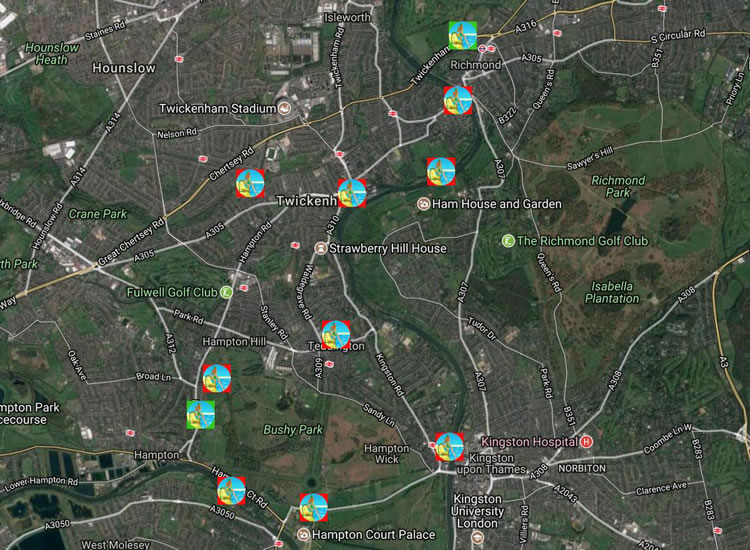
Early information about Teddington swimming pool when it was an outdoor pool, was supplied by Brian Holder, a well known member of the Teddington Society. Other local people also came forward with memories of the Teddington lido.
A photograph of Brenda Whittaker’s sister at Hampton Pool was one of the first photographs sent to the project by someone who used the outdoor pools, Brenda’s family were associated with the early Mereway pool and Brenda was swimming at Twickenham Lido on the day it closed – with no notification to those who used the pool, so its closure was very much a culture shock which still reverberates today.
Following advertisements in The Twickenham Tribune we came into contact with Russell Wilfred who has recently donated photographs taken by his father, Frederick Wilfred, to the Museum of London and since then, to Lidos Alive. This was an interesting introduction as Russell’s cousin, Patrick Dyos of The Stomping Nomads, saw the advertisement and contacted the project. Russell now lives in Finland and swims in the lakes but in his early years he swam in Twickenham Lido with his cousin.
Becky Horsbrugh and Julie McCarthy also contacted Lidos Alive with their stories of swimming at Twickenham outdoor pool - obviously an important part of their lives.
The history of the Twickenham Lido site was only recently discovered when an in depth study of the site and much primary research, funded by the Heritage Lottery, revealed that there had been a Richmond House on Twickenham Riverside for three hundred years; first a very grand stately home and later a more modest house. A lido on the site was the result of a petition by local people and became one of the most loved lidos in the borough; part of the social fabric of Twickenham. Since it closed in 1980 campaigns have raged as to the fate of the site and political parties have lost and won elections as a result and surprisingly enough we are currently in the midst of a similar situation.
Another find as a result of The Twickenham Tribune advertisements was a "new" Lido on the Thames at Hampton Wick. A postcard of this 1930s lido was sent in by Paul Barnfield.
Our earliest lido was in operation in 1895 (Mereway Bathing Place) but there was much outdoor swimming on the Twickenham side of the river before this time and no doubt way back into the past. We have Paul’s postcard of a lido on the Thames at Hampton Wick some time in the 1930s but nearby, off Messenger’s Island (Raven’s Ait), the archives of the Surrey Comet confirmed outdoor bathing in 1863. However, it seems that nude bathing was the order of the day, likewise in Strawberry Vale in 1890 (confirmed by the Richmond and Twickenham Times archives).
The Twickenham side of the river seems to have had its fair share of lidos in the past. So far, we have only found one in Richmond, now called Pools on the Park and originally Richmond Baths. We are sure there must have been outdoor pools similar to those on the Twickenham side and if so we hope to find them, and if not perhaps we can find the reason why.
The Art Deco style of many lidos, echoed in the Lidos Alive website, lends itself to a study of lido design and we hope that in the work which may follow that this may be an inspiration to lido design.

Richmond upon Thames College architecture students sketching at Thames Lido
Local architecture students are investigating the styles of lido buildings and we are currently waiting to see their ideas in the form of graphic representations and models. At the same time young filmmakers prepared to interview some of the people who have come forward with their memories. We have an interesting range of participants: local people who used to swim from the beaches along the Thames, those who swam in the make-shift outdoor pools, as well swimmers in the purpose-built lidos. Local historians will also have their say so we look forward to lively and informative memories videoes.
To return briefly to our introduction to this project page, Lido is the Italian word for beach. So, we found it appropriate to take the project to Italy – to Rome and the Global Junior Challenge (25 – 27 October 2017) - to talk to young people of all ages about various local projects including Lidos Alive.
The Challenge, known as the GJC, is a biannual digital competition organised by Fondazione Mondo Digitale, under the high patronage of the Italian Presidency. During the exhibition members of the team were pleased to speak to students and teachers from Robotica Sistov, an Italian school project, not only about our lidos but also about our town of Twickenham. As well as talking to them about Twickenham and Lidos Alive we were able to present them with a lovely book of photographs “Twickenham” by Andrew Wilson, which had been given to us by Bruce Lyons of the Twickenham Town Business Association to give to participants in the exhibition in Rome.

Finally for 2017, as the year comes to a close, Alan Winter has once again found an intriguing postcard of a stretch of the Thames at Marble Hill towpath in Twickenham where many people learned to swim during the first half of twentieth century: Marble Hill Lido, where construction took place to make this an area for swimmers, those learning and those keen on outdoor swimming.
We have asked local swimmers who have been swimming in the area for decades whether there were any outdoor swimming opportunities on the Richmond side of the river, apart from Pools on the Park (Richmond Baths). So far, none have been found; even one keen Richmond swimmer who swam in pools on the Twickenham side has not been able to recall anything on that side of the Thames.
Perhaps the several outdoor bathing places in Twickenham vs only one in Richmond could be explained by the fact that, as well as the Thames, Twickenham has little rivers, Crane, Longford, and Colne. If so, people would find it much easier in the old days using the little rivers rather than being hounded out of the Thames.
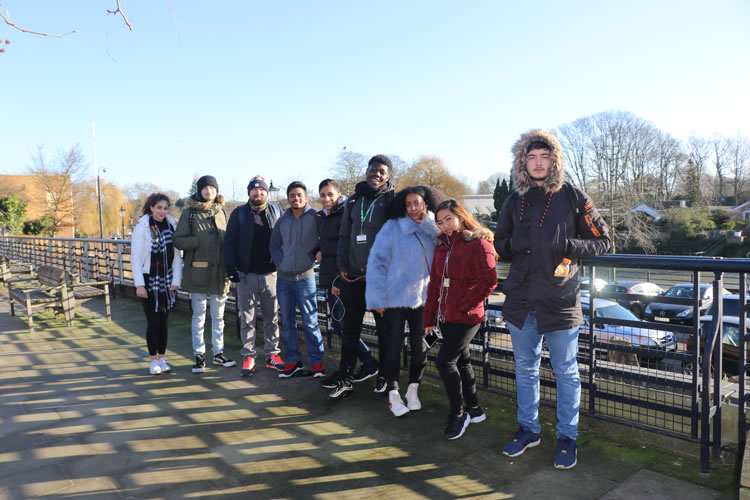
Architecture students from Richmond upon Thames College at the Diamond Jubilee Gardens (site of the former Twickenham Lido) 19th January 2018
On 23rd March we visited the architecture students from Richmond Upon Thames College to view their progress on lido designs. Below is a synopsis of their work at this stage.
Noris Obijiaku
One of the themes in students' work is the importance of proximity of a new lido to the river. This lido plan has a glass window looking out on to the Thames; the other side of the lido has coloured glass doors. The traditional Scandinavian use of wood is incorporated in lamps and seating as well as the use of the original fretwork seen at a visit to the Thames Lido in Reading.
Will Pereira
This plan is influenced by the traditional Polynesian architectural style. Wood and stone are used and a mixture of straight and curved lines, as well as a fin. A replica of a Polynesian mask could be used as a door within the lido. Islands of Polynesia: http://worldinfozone.com/features.php?section=EasterIsland
Junaid Sheikh
Traditional Japanese architecture and hot springs in mountain areas are the inspiration for this drawing - organic in style rather than rectangular. The river is on one side so there are views of the river and the pool on entering the lido. Materials are tiles, ceramics and wood; traditional Japanese sliding shoji doors are an important feature.
René Ballesteros
This plan aims to make the most of the view of the Thames; a natural feature that was not a part of the design of Twickenham Baths. The idea behind this plan is modern with a natural look. Green tiling was proposed for the pool area to give a green effect to the colour of the water.
There is also a stepped terrace model; a more organic design of the pool allowing for enjoyment of the water and social interaction.
Nadia Abdulkarim Ali
This design is based on a Roman Bath but is modern and minimalist. The pool is surrounded by wooden panels but marble is the main material used. There are waterfall taps at either end of the pool which contribute to the water supply. Stone is used for the changing rooms and sauna so everything blends.
Leen Khalifa
This design is influenced by the W hotel in Dubai; an infinity pool on the sea to be translated to a pool on the river. The lido is very modern inside: glass and black marble - no wood is used. Geometric designs are used for fixtures and fittings.
Krystel Marinas
This designer likes columns using Bath as an inspiration. It has a classical look outside but is more modern inside. The doors of the changing rooms could be made from a frosted plastic material. It was suggested that the designs for taps and other fittings could be part of the architectural style.
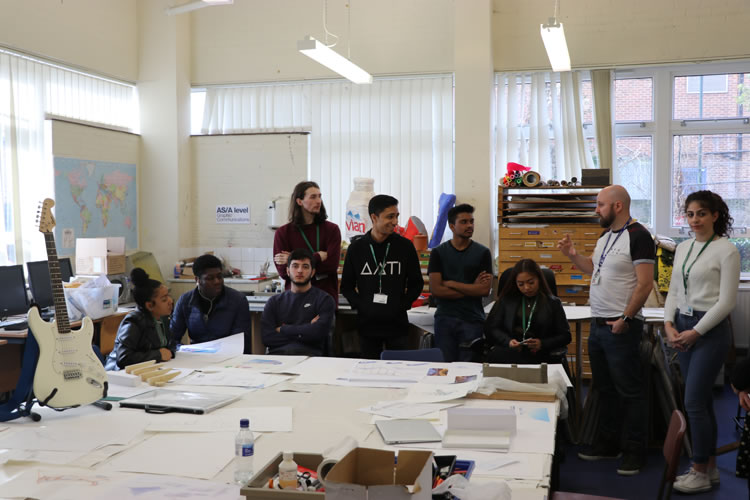
Architecture students from Richmond upon Thames College discussing their project work, 23rd March 2018
On Thursday 29 March 2018 the Lidos Alive project was presented to the Twickenham Society, one of the oldest amenity societies in Twickenham. A very interesting presentation was given by Professor Jeremy Hamilton-Miller about the history of bathing and the introduction of public baths.
Berkley Driscoll and Teresa Read spoke about outdoor swimming in the Borough from the early nineteenth century, mainly on the Twickenham side. Despite a great deal of research very little has been discovered about lidos on the Richmond side of the Borough although Twickenham has had more than its fair share of lidos, many of which were unknown in the present day until research was carried out by the Lidos Alive team.
Members of the Lidos Alive team were present at the event and made contributions to the question and answer session at the end of the talk. A representative from the Hampton Pool Trust - probably the first lido in the country to be saved during the time when lidos were closing - was in the audience.
All those attending the presentation were given a Lidos Alive publication and further copies will be given to local residents during further presentations and on request.
Soon after the presentation to the Twickenham Society the REIC set up their travelling exhibition on 23 April in the function room at the Alexander Pope Hotel in Strawberry Hill (Twickenham).
The following were exhibited: six information boards with photographs of all our lidos, past and present - and, additionally, two printed free standing information banners about Lidos Alive. Our lido and map images were also projected on to a large screen and our memories videos were on a loop on a television screen on the wall.
Free Lidos Alive booklets were given to visitors detailing information of all the lidos in the project and a copy of Liquid Assets by Janet Smith was available.
A number of local people visited the exhibition including participants in the project. Very interesting conversations took place with visitors actively interested in the lidos, their locations and history. This was definitely one of the most successful and interactive exhibitions arranged by the REIC.
We ended the evening projecting a copy of our book "Lidos Alive - a history of our lidos" (Boroughs of Twickenham and Richmond) on the television screen.
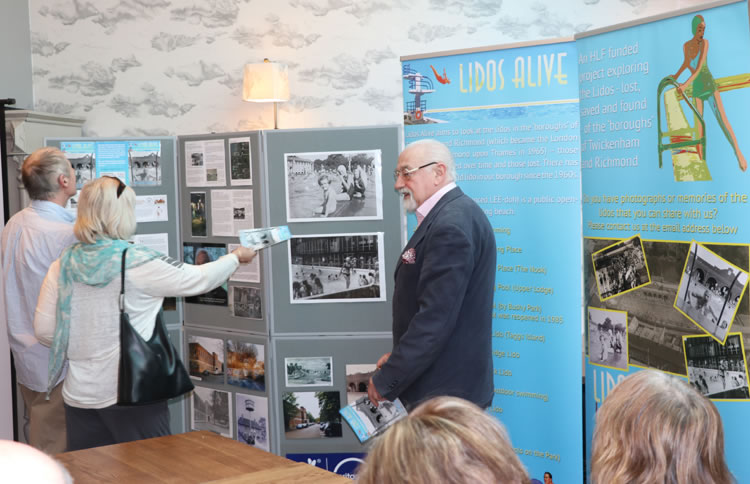
Throughout this project the project team has engaged with local people who have memories of our lidos and outdoor swimming.
The Lidos Alive project team started with four known local lidos: Hampton, Teddington, Twickenham and Pools on the Park (Richmond Baths) finishing with eleven local lidos (past and present) as well as information about outdoor swimming in the River Thames prior to the lidos.
As well as our local lidos we looked at lidos further afield and considered the similarities of the rise and fall of the lido and the current resurgence in outdoor swimming which has led to a number of lidos being saved.
Local college students who took part in the project visited the recently renovated lido in Reading, the Thames Lido.
Not only have students from Richmond upon Thames College taken part in the project interviewing and filming local people's memories but the AS architecture course (one of three in the country) may include the lido project in its programme for new students from March 2019. Sketches and models of the students' creative ideas for a lido in Twickenham will form part of their coursework.
College lecturers have appreciated the importance of a real project; the project as the "client" giving students the opportunity to work to an outside brief. The project team has also been aware of providing information for the students to build up a picture of the history of the lidos to enable them to understand the nature of what is required.
A copy of Liquid Assets: The Lidos and Open Air Swimming Pools by Janet Smith, with a foreward by Tracey Emin, was provided by Lidos Alive as a course text book.
The production of the website has been central as a depository for information about the lidos and also for the output of the students' work, both memories videos and documentation of students' architectural ideas.
Those of us who have provided our memories and other background information have been given more impetus as we have seen this used in our local college by a number of students, both local and those from further afield. So, it seems that the project has been such a success that it will be repeated again next year.
Local community media has also played its part; the online Twickenham Tribune has documented Lidos Alive disseminating the project to a wide audience of over twenty thousand people in the towns in the Borough.
Thus, a combination of historical research and obtaining memories from those who used bygone facilities has produced some fascinating and unexpected results. We have shown how open-air bathing in rivers as the only means of washing for some during the 19th and early 20th century morphed slowly but surely into the architectural delights of lidos during the 1920s and 1930s. This was followed by the sad inexorable decline during and after the War. There are now perhaps traces of a possible resurgence, that we sincerely hope will be maintained.
The specifics of the local situation has been described and illustrated in the preceding pages. It is remarkable how in Twickenham many lidos came and then disappeared, while it appears that there has been a paucity on the Richmond side of the river.
The recorded memories concerning some of these lidos make an invaluable permanent record of these previously under-explored features. The history of perhaps the most iconic one, Twickenham Lido on the Riverside between 1935 and 1980, has already been covered by our earlier project “Memories of Twickenham Riverside”, and has been augmented here.
As with the other REIC (Richmond Environmental Information Centre) Heritage Lottery projects: Memories of Twickenham Riverside http://www.memoriesoftwickenhamriverside.com and the Ice Rink in East Twickenham http://icerinx.com, Lidos Alive will continue to be alive in the community and members of the project team will present the project at various local amenity group meetings and other events as requested.
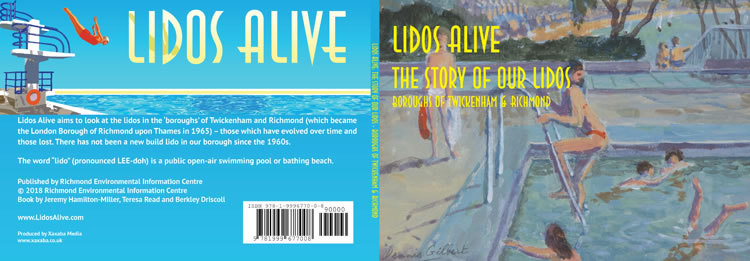
A book of the project has been printed; to find out how to buy a copy contact us at contact@LidosAlive.com
Project Acknowledgements:
Michael Bangham, Paul Barnfield, Ray Brodie (Royal Parks), Sir Vincent Cable MP, Dennis Gilbert (artist), Paul Evans (Bushy Park), Simon Griffiths (Outdoor Swimmer magazine), Grahame Hadden, Brian Holder, Becky Horsbrugh, Ken Howe, Dik Leatherdale, Carrie Lees, Julie McCarthy, Jo Pond, Alan Winter, Brenda Whittaker, Ian Whittaker, Russell Wilfred, Keith Wait, Alban Lowe,
Richmond upon Thames College (RuTC) students from Creative Media: George Griffin, Isabella Kean, Jake Lizcano, Ben Reininger, Davinder Teji (lecturer), Marius Smuts (lecturer). RuTC AS Architecture students: Nadia Abdulkarim Ali, René Ballesteros, Leen Khalifa, Krystel Marinas, Noris Obijiaku, Will Pereira, Junaid Sheikh, Martin Williams (lecturer), Tim Pond (lecturer), Mark Thwaites and the Thames Lido, Reading, students and teachers from Robotica Sistov, Italy, Camp Bay Lido, Gibraltar and Shona Lyons and Bruce Lyons of the Twickenham Town Business Association.
Richmond Environmental Information Centre: Berkley Driscoll, Jeremy Hamilton-Miller and Teresa Read.
We would also like to thank Rachel Cull, our Case Officer at the Heritage Lottery as well as many local people who have supported this project.
A special thanks goes to Dennis Gilbert (a member of the New English Art Club - NEAC) for the use of his paintings in Lidos Alive - The Story Of Our Lidos (Boroughs of Twickenham and Richmond).
If you are interested in sharing your memories, either on film or by email, please let us know contact@LidosAlive.com


